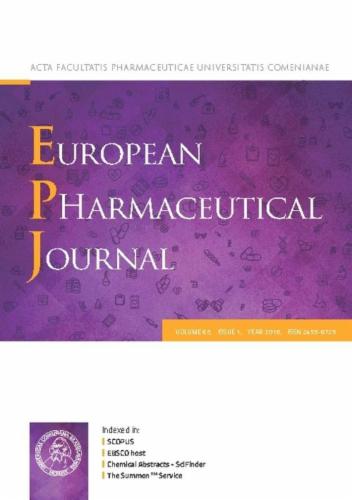对抗药性结核病有活性的异烟肼衍生物的膜相互作用研究。
IF 4.3
3区 医学
Q1 PHARMACOLOGY & PHARMACY
引用次数: 0
摘要
结核病是世界范围内死亡的主要原因之一,原因是多种耐药菌株的增长对现有疗法不敏感。研究了异烟肼(INH)及其衍生物N′-癸烷基异烟碱肼(INH- c10)、N′-(E)-(4-苯氧苄基)异烟碱肼(N34)和N′-(4-苯氧苄基)异烟碱肼(N34red)。由于INH-C10和N34对结核分枝杆菌(Mtb)耐药的主要突变具有良好的体外选择性指数,并且具有合适的亲脂性和与人血清白蛋白的相互作用,因此被认为是有前景的抗结核化合物。N34red与N34的区别仅在于N′ = 键的饱和度,但其选择性指数较差。为了更深入地研究这些化合物的治疗潜力,本文评估了它们与生物膜模型的相互作用,模拟了结核分枝杆菌细胞内通往靶标的生物屏障。除N34red外,所有化合物都削弱了刚性脂质凝胶相中酰基链的堆积,尤其是INH-C10,它是唯一干扰液体无序膜的化合物。值得注意的是,除了INH外,所有化合物都降低了所有类型双分子层的膜偶极电势,但只有N34red有明显的影响。在凝胶相双分子层中的插入表明,这些化合物可能能够穿透结核分枝杆菌坚硬的细胞壁。Förster的共振能量转移(FRET)实验表明,在模拟人细胞膜的液有序/液无序横向异质性的三元双层中,化合物既不影响脂质结构域的大小,也不影响脂质结构域的组织。这些结果为INH-C10和N34对人类细胞系的低毒性和提高对耐药Mtb的活性提供了分子见解。本文章由计算机程序翻译,如有差异,请以英文原文为准。

Membrane interaction studies of isoniazid derivatives active against drug-resistant tuberculosis
Tuberculosis is one of the leading causes of mortality worldwide due to the growth of multi-drug resistant strains unsusceptible to currently available therapies. Four compounds, isoniazid (INH) and three derivatives, N'-decanoylisonicotinohydrazide (INH![]() C10), N'-(E)-(4-phenoxybenzylidene)isonicotinohydrazide (N34) and N’-(4-phenoxybenzyl)isonicotinohydrazide (N34red), were studied. Owing to their advantageous in vitro selectivity index against the primary mutation responsible for drug resistance in Mycobacterium tuberculosis (Mtb), as well as their suitable lipophilicity and interaction with human serum albumin, INH
C10), N'-(E)-(4-phenoxybenzylidene)isonicotinohydrazide (N34) and N’-(4-phenoxybenzyl)isonicotinohydrazide (N34red), were studied. Owing to their advantageous in vitro selectivity index against the primary mutation responsible for drug resistance in Mycobacterium tuberculosis (Mtb), as well as their suitable lipophilicity and interaction with human serum albumin, INH![]() C10 and N34 were deemed promising antitubercular compounds. N34red, despite differing from N34 only in the saturation of the N′ = C bond, presents a poor selectivity index. To delve deeper into the therapeutic potential of these compounds, their interaction with biomembrane models, mimicking biological barriers on the way to the target inside Mtb cells, was herein evaluated. All compounds, except N34red, weakened the packing of the acyl chains in the rigid lipid gel phase, especially INH
C10 and N34 were deemed promising antitubercular compounds. N34red, despite differing from N34 only in the saturation of the N′ = C bond, presents a poor selectivity index. To delve deeper into the therapeutic potential of these compounds, their interaction with biomembrane models, mimicking biological barriers on the way to the target inside Mtb cells, was herein evaluated. All compounds, except N34red, weakened the packing of the acyl chains in the rigid lipid gel phase, especially INH![]() C10, which was the only compound disturbing liquid disordered membranes. Notably, all compounds except INH decreased membrane dipole potential, across all types of bilayers studied, but only N34red had a drastic effect. The insertion in gel phase bilayers suggests that the compounds may be able to penetrate the rigid cell wall of Mtb. Förster's resonance energy transfer (FRET) assays in ternary bilayers with liquid ordered/liquid disordered lateral heterogeneity mimicking human cell membranes, showed that the compounds affected neither the size nor the organization of lipid domains. These results provide molecular insights into the low toxicity against human cell lines and improved activity against drug-resistant Mtb of INH
C10, which was the only compound disturbing liquid disordered membranes. Notably, all compounds except INH decreased membrane dipole potential, across all types of bilayers studied, but only N34red had a drastic effect. The insertion in gel phase bilayers suggests that the compounds may be able to penetrate the rigid cell wall of Mtb. Förster's resonance energy transfer (FRET) assays in ternary bilayers with liquid ordered/liquid disordered lateral heterogeneity mimicking human cell membranes, showed that the compounds affected neither the size nor the organization of lipid domains. These results provide molecular insights into the low toxicity against human cell lines and improved activity against drug-resistant Mtb of INH![]() C10 and N34.
C10 and N34.
求助全文
通过发布文献求助,成功后即可免费获取论文全文。
去求助
来源期刊
CiteScore
9.60
自引率
2.20%
发文量
248
审稿时长
50 days
期刊介绍:
The journal publishes research articles, review articles and scientific commentaries on all aspects of the pharmaceutical sciences with emphasis on conceptual novelty and scientific quality. The Editors welcome articles in this multidisciplinary field, with a focus on topics relevant for drug discovery and development.
More specifically, the Journal publishes reports on medicinal chemistry, pharmacology, drug absorption and metabolism, pharmacokinetics and pharmacodynamics, pharmaceutical and biomedical analysis, drug delivery (including gene delivery), drug targeting, pharmaceutical technology, pharmaceutical biotechnology and clinical drug evaluation. The journal will typically not give priority to manuscripts focusing primarily on organic synthesis, natural products, adaptation of analytical approaches, or discussions pertaining to drug policy making.
Scientific commentaries and review articles are generally by invitation only or by consent of the Editors. Proceedings of scientific meetings may be published as special issues or supplements to the Journal.

 求助内容:
求助内容: 应助结果提醒方式:
应助结果提醒方式:


